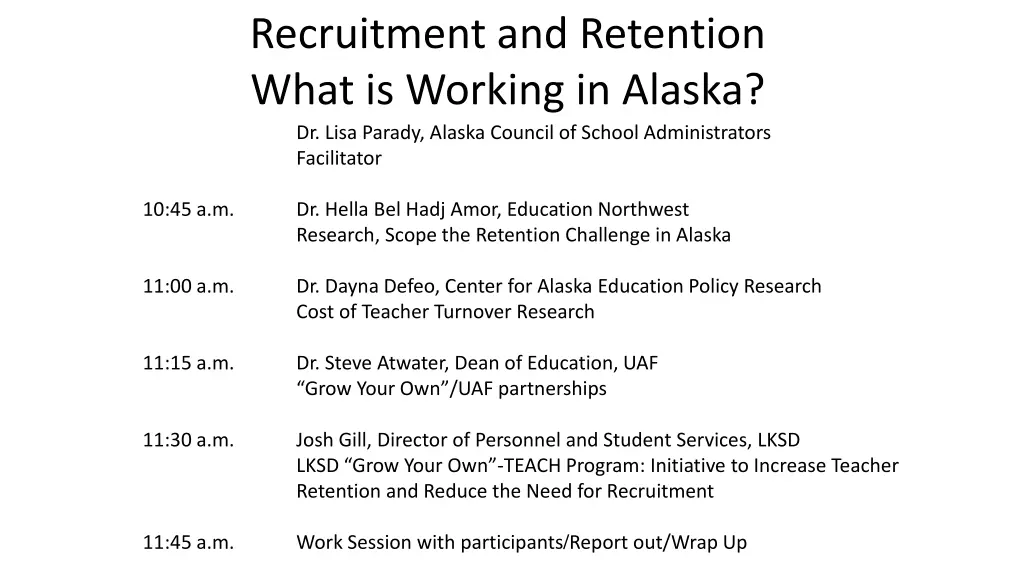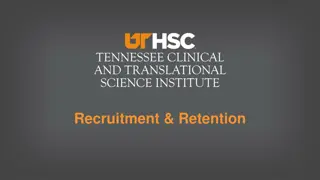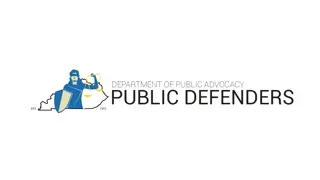
Understanding Educator Retention Challenges in Alaska
Gain insights into the scope of educator retention challenges in Alaska through a series of presentations and discussions focusing on recruitment, retention initiatives, and data analysis. Learn about efforts to improve teacher retention and reduce the need for constant recruitment in Alaskan schools.
Download Presentation

Please find below an Image/Link to download the presentation.
The content on the website is provided AS IS for your information and personal use only. It may not be sold, licensed, or shared on other websites without obtaining consent from the author. If you encounter any issues during the download, it is possible that the publisher has removed the file from their server.
You are allowed to download the files provided on this website for personal or commercial use, subject to the condition that they are used lawfully. All files are the property of their respective owners.
The content on the website is provided AS IS for your information and personal use only. It may not be sold, licensed, or shared on other websites without obtaining consent from the author.
E N D
Presentation Transcript
Recruitment and Retention What is Working in Alaska? Dr. Lisa Parady, Alaska Council of School Administrators Facilitator 10:45 a.m. Dr. Hella Bel Hadj Amor, Education Northwest Research, Scope the Retention Challenge in Alaska 11:00 a.m. Dr. Dayna Defeo, Center for Alaska Education Policy Research Cost of Teacher Turnover Research 11:15 a.m. Dr. Steve Atwater, Dean of Education, UAF Grow Your Own /UAF partnerships 11:30 a.m. Josh Gill, Director of Personnel and Student Services, LKSD LKSD Grow Your Own -TEACH Program: Initiative to Increase Teacher Retention and Reduce the Need for Recruitment Work Session with participants/Report out/Wrap Up 11:45 a.m.
Alaska State Policy Research Alliance: Informing issues with data and evidence Educator Retention May 22, 2017 Dr. Hella Bel Hadj Amor
This Segment Goal: To gain an understanding of the scope of the retention challenge in Alaska Agenda Introductions Origin of the work Review of original data analysis on retention in Alaska schools
Alaska State Policy Research Alliance (ASPRA) Produce and share evidence on Alaska education issues
ASPRA Stakeholders School districts Department of Education & Early Development (DEED) Alaska Superintendents Association University of Alaska Dr. Steve Atwater Alaska Association of School Boards
ASPRA Working Groups School leadership Educator pipeline State education policy Early childhood
Educator retention analysis National research DEED and original analysis Public and DEED data Differences Teacher, principal, and superintendent school/district turnover and retention Turnover new Retention stay Tenure years
DEED turnover analysis 2016-17 Teachers Inter-district: 10.5% Intra-district: 12.8% Total: 22.0% of teachers new to their school Administrators: 30.3% 177 of 584 new to their school
Turnover rates across U.S. Teachers (2013): Nationally 14% Alaska 17% Hawaii 21% Idaho 13% Montana 19% Oregon - 12% Washington 10% Principals: 15 Principals: 15- -30% across districts 30% across districts Alaska has 3 Alaska has 3rd rd- -lowest average tenure lowest average tenure Superintendents: ~15% annually Superintendents: ~15% annually Up to 45% exit in 3 years Up to 45% exit in 3 years Typically move out of high Typically move out of high- -poverty/rural schools poverty/rural schools
Newly certified & new to state Teachers About 10% of teachers new to the state each year for last 5 years (~800 new of 8000) Principals In 2013, 13% of principals were new to state Down to 7% by 2017 (27 new of 397) Superintendents In 2017, only 1 superintendent new to state
School turnover Principal 27 26 25 23 22 22 20 19 18 18 Teacher 2013 2014 2015 2016 2017
Defining urban/rural schools Urban (on- and off-road) Anchorage, Fairbanks, Juneau Urban/rural fringe (on- and off-road) Palmer, Seward, Sitka Rural hub/fringe (on- and off-road) Bethel, Healy, Unalaska Rural remote (off-road) Adak, Arctic Village, Yakutat
School turnover by category 2016/17 Principal Teacher Urban 21 14 12 Urban/rural fringe 16 Rural hub/fringe 21 21 32 32 Rural remote
District turnover Principal 16 16 16 13 13 12 12 12 Teacher 2013 2014 2015 2016 2017
Superintendent turnover 43 72% of districts with superintendent turnover in last 5 years 28 24 19 4 2013 2014 2015 2016 2017
Strategies to increase retention Caveat: Not all turnover is negative Grow-your-own staff and leadership Educators Rising Para-educator support Improve onboarding of new staff Connections to community Connections to other staff
Strategies to increase retention Build incentives to stay in contracts Example: bonus after 2 years Encourage networks within and across districts Key for rural districts Can be virtual and/or in-person
Contact information Dr. David Stevens, Research Manager Education Northwest David.Stevens@educationnorthwest.org Dr. Ashley Pierson, Senior Researcher Education Northwest Ashley.Pierson@educationnorthwest.org Dr. Hella Bel Hadj Amor, Leader: Applied Research and Technical Support Education Northwest Hella.Belhadjamor@educationnorthwest.org
Cost of teacher turnover study Dayna Jean DeFeo, PhD Trang Tran, MPP; Diane Hirshberg, PhD; Dale Cope, PhD; Pam Cravez, JD
Current CAEPR research focus College & career readiness Teacher supply & demand Indigenous education
Types of teacher turnover (TT) Retirement Teacher ends teaching professional career, usually at certain age or years of service Attrition Teacher leaves profession entirely, premature to retirement Migration Teacher leaves current job for teaching position in new district Transfer Practicing teacher moves to new subject area.
Alaska TT context Stevens & Pierson, 2017 2015-2016 School-level turnover Urban 14% Urban fringe 16% Rural hub 21% Rural remote: 31% Total: 22.0% of teachers new to their school Hill & Hirshberg, 2013 2004-2013 District-level turnover Rural: 20% - 12 districts at 30% Urban (big 5): 10% Teachers prepared in Alaska stay longer
TT categories and cost examples Administrative tasks Exit interviews Separation Job fairs: travel, registration, per diem Advertising Recruitment Applications, interviews, background checks HR processing Hiring New teacher orientation & mentoring Professional development Orientation & training Coursework, field placement Certification Preparation Teacher productivity Student learning
Method What we did Ingredients method Interviews with 37 superintendents (or designees) Code turnover tasks Estimate time Code staff Estimate wage AASB, NEA-Alaska, ALARI Estimate fixed costs Calculate total cost Weight total cost Delimitations District as unit of analysis Exclude: Lost productivity Preparation Extreme & infrequent circumstances
District-level TT expenditures in 6 cost categories Orientation & training Performance productivity Separation Recruitment Hiring Preparation Our per-teacher cost calculation $2,448.95 $1,910.35* $4901.91 $11,169.86 (not calculated) (not calculated) Percent of our total cost calculation 11.99% 9.35% 23.99% 54.67% . . Screening applicants, interviews, and administrative processes Professional development, onboarding, and new teacher support Administrative, maintenance, and security tasks Estimate includes Job fairs, advertising Our total calculated cost: $20,431.08 *Excludes wages material costs only
Additional costs of TT not represented in our analysis School-level costs District-level costs State costs Teacher costs Community costs Terminations, teachers leaving mid-year, contracted services, benefits Impact on schedules & school climate Separation ATP Recruitment Wages & benefits $110,000/year Teachers & principals serve in hiring process Elders & parents serve on hiring committees Hiring Benefits Senior teachers & principals mentor new hires Orientation & training ASMP Benefits $750,000/year Performance productivity 40.92% of turnover costs (all costs) $55,912/4-year degree $25,822/4-year degree Preparation
So what? Implications The cost of TT is considerable. Not all TT is bad, nor are all turnover costs. Retention pays off. Reducing costs in one area may create additional costs elsewhere. Recommendations Better track TT costs at multiple levels. Explore conditions impacting TT. Explore how to reduce costs.* Increase Alaska-prepared teacher supply. Improve teacher supports. Recruit on community strengths. Ongoing research.
For more information Visit our website:http://www.iser.uaa.alaska.edu/CAEPR/ Read the full report: http://www.iser.uaa.alaska.edu/Publications/2017- CostTeacher.pdf Contact the researchers: Dayna Jean DeFeo djdefeo@alaska.edu 907.786.5494 Trang Tran tctran@alaska.edu 907.786.6727 Diane Hirshberg dbhirshberg@alaska.edu 907.786.5413 Follow us on Twitter: UAA_CAEPR
Grow Your Own/UAF partnerships Dr. Steve Atwater, Dean of Education
Lower Lower Kuskokwim Kuskokwim TEACH TEACH Program Program Grow Your Own The Lower Kuskokwim School District initiative to increase teacher retention and reduce the need for teacher recruitment.
The Mission of the LOWER KUSKOKWIM SCHOOL DISTRICT is to ensure bilingual, culturally appropriate and effective education for all students, thereby providing them with the opportunity to be responsible, productive citizens.
BOARD PRIORITIES Student Academic Performance Yugtun Language Development Students taught by Certified Teachers in every class, every day
Participant Categories Associate Teachers District Employees Non-District Fluent Yugtun Speakers Non-District Non-Fluent Speakers with 5+ years living in district Two and Done Endorsement & Educational Leadership Board Scholarships
TEACH Program and Student Teachers Total of 671 credits taken 2016-17, not including summer Includes Two and Done, Associate Teachers, additional categories Does not include Education Leadership credits
Associate Teachers Spring 2017 there are 41 Associate Teachers in LKSD schools All required to take a minimum of 9 credits per year- fall, spring, summer Associate Teachers are required to be in TEACH Program and attain State of Alaska Type I certification Levels: 0-59 credits- Associate Teacher III 60-100 credits- Associate Teacher IV 101+ credits- Associate Teacher V
Associate Teachers Name Site Associate Level Sharon Alexie Tamara Anaver Elena Anthony Aldora Atti Gideon Azean Bosco Carl Elena Brown Charlene Carl Adeline Charles Anita Chase Keri Cleveland Richard Cleveland Nicolette Daniel Alice Fitka Loretta Flynn Nettie Igkurak Sherman Igkurak Staci Igkurak Stella Jackson Betsy Jenkins Ayaprun Elitnaurvik Kipnuk Nightmute Kwigillingok Kongiganak Newtok Quinhagak Newtok Bethel Nunapitchuk Quinhagak Quinhagak Tuntutuliak Tuntutuliak Newtok Kwigillingok Kongiganak Kwigillingok Nightmute Atmautluak III III III III III III III IV III III III IV III III III III IV III III III
Name Site Associate Level Associate Teachers Alison Kassel-Waska Julia Lewis Nellie Lincoln Lucy Lupie Stephanie Maxie Carrie McIntyre Katy Miller Mary Nicolai Lisa Olick Eva Panruk Sophie Paul Martha Perry Veronica Simons Xavier Slats Bertha Therchik AnnMarie Tinker Howard Tinker Olga Uttereyuk Anne White Peggy Williams Mekoryuk Bertha Kashatok Nightmute Akiuk Chefornak Tununak Tuntutuliak Bethel Tuntutuliak Eek Kwethluk Tuntutuliak Chefornak Kipnuk Ayaprun Elitnaurvik Toksook Bay Ayaprun Elitnaurvik Toksook Bay Akiuk Akiuk Kwethluk Tuntutuliak III IV III III III III III III III III III III III III IV III IV III III III III
LKSD Employees Spring 2017 there are 11 district employees in the TEACH program All required to take a minimum of 9 credits per year- fall, spring, summer TEACH Program participants in this category must apply for acceptance
District Employees accepted into the TEACH Program Name Site Allen Abraham Chefornak Glen Charlie Napakiak Mary Charlie-Smith Mekoryuk Georgiann Jacob Atmautluak Eliza Joekay Oscarville Olga Mesak Oscarville Kathleen Naneng Bethel Peter Nelson Napakiak Warren Nicolai Bethel Zach Pleasant Bethel Ruth Tikiun Atmautluak
Non-district employees accepted into the program who are fluent in Yugtun and have a degree Spring 2017 there are no current TEACH Program participants in this category
Non-district employees accepted into the program who are fluent in Yugtun and do not have a degree Spring 2017 there is one TEACH Program participant in this category Zoie Kernak- UAF Kuskokwim Campus All are required to take a minimum of 9 credits per year- fall, spring, summer
Two and Done Special category for TEACH Program Associate Teachers who are within two years of finishing their Bachelor s degrees Participants take full-time coursework and do not teach Minimum of 15 credits per semester, space for study in school and technology access provided by district Receive a stipend from the district in the amount they would earn in salary Must meet all other requirements of the program Must have recommendation of advisors at UAF and concurrence of LKSD administration
Two and Done 2016-17 four participants: Emma Petluska- Quinhagak Rita Joekay- Napaskiak Kimberly Nicholai- Napaskiak Isabelle Dyment- Ayaprun Elitnaurvik Required full time course load- fall, spring, most are taking summer also
Two and Done for 2017-18 Continuing: Emma Petluska Rita Joekay Kim Nicholai Isabelle Dyment Potential Two and Done: Charlene Carl-Newtok- Needs 38 credits before internship Richard Cleveland-Quinhagak- Needs 42 credits before internship Alison Kassel-Waska-Akiuk-Needs 31 credits before internship AnnMarie Tinker-Akiuk- Needs 33 credits before internship
Endorsements Endorsements Hard to fill needs: Special Education, Math Currently: Haley Krautbauer- Special Education Kathy Cleveland- Special Education
Educational Leadership: Administration Erin Charles Vicki Spencer Cassius Brown Natalie Cowley Alicia Miner






















